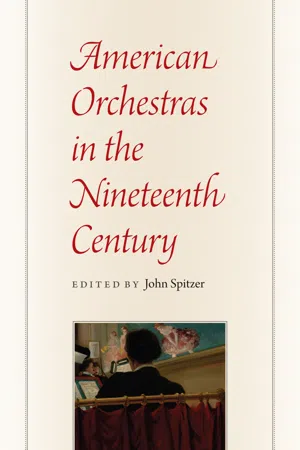![]()
NOTES
Introduction: Toward a History of American Orchestras in the Nineteenth Century
1 · For analysis of this historiographical trait, see Lydia Goehr, The Imaginary Museum of Musical Works: An Essay in the Philosophy of Music (2007), and in particular her chapter “After 1800: The Beethoven Paradigm,” 205–42.
2 · See Frédéric Louis Ritter, Music in America (1970). For an excellent discussion of Ritter and other authors who wrote comprehensive histories of American music, see Richard Crawford, The American Musical Landscape: The Business of Musicianship from Billings to Gershwin (1993), 3–37.
3 · Ritter, Music in America, 341. On the Germania Musical Society, see chapter III.4 in this volume.
4 · Ritter, Music in America, 343.
5 · W. S. B. Mathews, A Hundred Years of Music in America (1889), iv. On Mathews’s career in Chicago, see chapter II.4 in this volume.
6 · Ritter’s carefully documented account of the founding of the New York Philharmonic contains a curious error: he gives U. C. Hill’s first name as “Uriah” rather than Ureli (Ritter, Music in America, 273). Later writers, such as Mathews, who repeat this error can be assumed to be basing their accounts on Ritter.
7 · Henry Edward Krehbiel, The Philharmonic Society of New York: A Memorial (1892), 17.
8 · Krehbiel’s book spurred the writing of “official” histories of a few other orchestras, including M. A. DeWolfe Howe, The Boston Symphony Orchestra: An Historical Sketch (1914; rev. ed., 1931); Philo Adams Otis, The Chicago Symphony Orchestra: Its Organization, Growth and Development, 1891–1924 (1924); and Frances Anne Wister, Twenty-Five Years of the Philadelphia Orchestra, 1900–1925 (1925). The several histories of the New York Philharmonic would make a fascinating study in their own right. They include: James Gibbons Huneker, The Philharmonic Society of New York and Its Seventy-Fifth Anniversary: A Retrospect (1917) at the orchestra’s 75th anniversary; John Erskine, The Philharmonic-Symphony Society of New York: Its First Hundred Years (1943) for the centennial; Bert Bial, Focus on the Philharmonic (1992) for the 150th; and particularly Howard Shanet’s fine book, Philharmonic: A History of New York’s Orchestra (1975), which attracted many scholars and archivists to the subject of orchestral history.
9 · Charles Seeger traced the movement’s history in “Music and Class Structure in the United States” American Quarterly 9 (1957). I am grateful to Stephen R. Greene, “Visions of a ‘Musical America’ in the Radio Age” (Ph.D. diss., 2008), for bringing Seeger’s article and the “Good Music” movement to my attention.
10 · W. J. Henderson, What Is Good Music? Suggestions to Persons Desiring to Cultivate a Taste in Musical Art (1898).
11 · Louis C. Elson, The History of American Music (1925), 58.
12 · Ibid., 59, 68.
13 · Charles Edward Russell, The American Orchestra and Theodore Thomas (1927), vii, v. This study was supplanted in the third generation of scholarship by Ezra Schabas, Theodore Thomas: America’s Conductor and Builder of Orchestras, 1835–1905 (1989).
14 · W. Dermot Darby obituary, New York Times, October 21, 1947. See also Richard Jackson, United States Music: Sources of Biography and Collective Biography (1973), 19.
15 · Arthur Farwell and W[illiam] Dermot Darby, Music in America (1915), 201.
16 · By the time of his third edition (1946), Howard had become curator of the Americana Collection of the Music Division of the New York Public Library, with access to relatively vast numbers of original documents. He was the first of the panoptic historians of American music to get Ureli Corelli Hill’s name right (p. 151).
17 · John Tasker Howard, Our American Music (1965), 280, 282, 289.
18 · H. Wiley Hitchcock, Music in the United States: A Historical Introduction (1988), 89, 90, 91–92.
19 · Charles Hamm, Music in the New World (1983), 317. A member of the planning group for the Rockefeller Foundation’s New World Records project, Hamm organized his book around music available on sound recordings.
20 · Richard Crawford, America’s Musical Life: A History (2001), 313, 307, 291.
21 · Perhaps the earliest of these studies was Henry Charles Lahee, The Orchestra: A Brief Outline of Its Development in Europe and America, with a Description of the Instruments and Their Functions (1925), but at only forty-eight pages and with limited distribution it did not have a national audience. Margaret Grant and Harman S. Hettinger, America’s Symphony Orchestras, and How They Are Supported (1940), contains a chapter on symphony orchestras before 1900, largely derived from Ritter, but it primarily surveys the finances of twentieth-century organizations and argues for a National Bureau of Fine Arts.
22 · John Henry Mueller, The American Symphony Orchestra: A Social History of Musical Taste (1951). Twenty-two years later, Mueller’s wife, Kate Hevner Mueller, added nineteen orchestras and extended the data through 1970 but abandoned the attempt to link programming with social history: Twenty-Seven Major American Symphony Orchestras: A History and Analysis of Their Repertoires, Seasons 1842–43 through 1969–70 (1973).
23 · Judith Sealander, Private Wealth and Public Life: Foundation Philanthropy and the Reshaping of American Social Policy from the Progressive Era to the New Deal (1997), 5.
24 · Philip Hart, Orpheus in the New World: The Symphony Orchestra as an American Cultural Institution (1973).
25 · Joseph Horowitz, Wagner Nights: An American History (1994). His Classical Music in America: A History of Its Rise and Fall (2005) extends his ideas to other composers and to other genres beyond the orchestra, addressing su...
